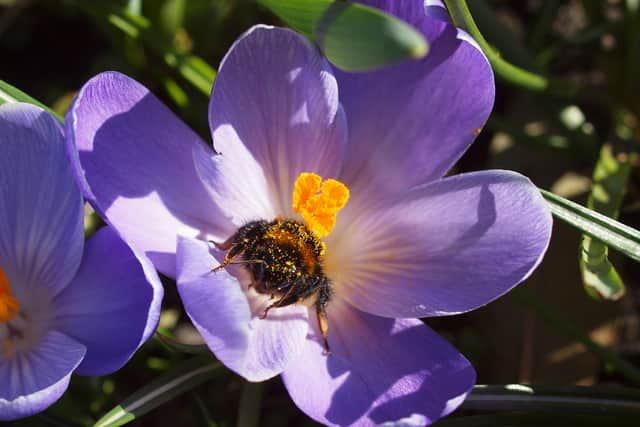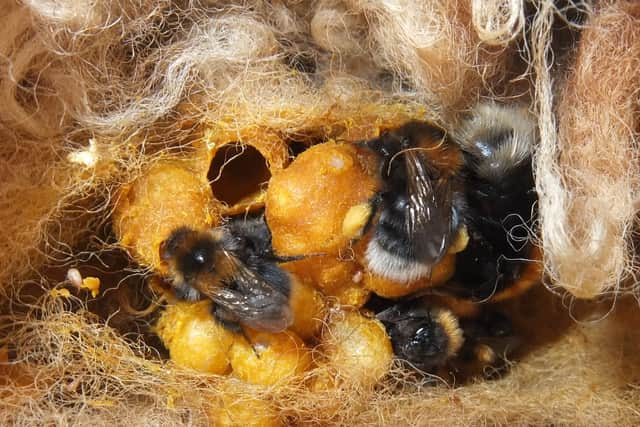Bumblebee Conservation Trust: How to attract bumblebees to your garden - and help save species in strife
and live on Freeview channel 276
It might still be early days with a bit of a chill in the air, but spring is definitely fast on its way to the British Isles.
With it comes the return of one of the UK's most beloved garden icons; the charming and fluffy bumblebee - with newly emerged queens already to be found awkwardly tottering about the flowerbeds. The UK was once home to at least 26 different bumblebee species, according to conservation charity Buglife, but unfortunately, many of them are in trouble. At least two are now thought to be extinct, while six have fallen in numbers by more than 80% in recent years.
Advertisement
Hide AdAdvertisement
Hide AdBumblebees do a lot for us. They're vital in pollinating crops like apples and raspberries, experts say, and they are native insects - important parts of their ecosystems. Like much of British wildlife, they face a barrage of threats from the warming climate to pesticide use, but the biggest threat they face comes from our changing landscapes and countryside - as the diverse wildflower meadows they depend on turn into apartment blocks or intensive farms.
Luckily, there is plenty we can do to help support them before it's too late. The Bumblebee Conservation Trust has shared all sorts of information on how Britons can make their own gardens safe and inviting for the fuzzy critters, via its Bee the Change campaign. Here's what they say on turning your own patch into a haven for bumblebees:


Flourishing flowers
As many species of bumblebees start emerging from their winter slumber, the first thing they need is an energy boost - in the form of something to eat. Bumblebees rely on nectar and pollen from flowers first and foremost, the Trust says, so what you plant in your garden can help make sure bees have a plentiful food supply, when they really need it most.
You can help them out no matter what size your garden is, from a fully-fledged yard to even just a few flowerpots. In the early days of March, some of the best flowering plants to start growing include all kinds of mint and nasturtium (which you can use in your own kitchen too), as well as bugle and hardy geranium varieties. These last two should begin flowering within weeks, and will keep doing so through to September - near the end of bumblebee season.
Advertisement
Hide AdAdvertisement
Hide AdApril is a good time to plant chives, sunflower, and borage, the Trust says. Impressive sunflowers grow quickly from seeds, while cucumber-scented borage - sometimes called 'starflower' - can refill the nectar in its delicate blue flowers every few minutes.
As the months become warmer, you might want to try growing your own tomatoes - and the bees will thank you for it too. Bumblebees will also help pollinate your strawberry plants, and will never say no to sweet-smelling English lavender. Rosemary, thyme, and oregano grow well in pots and make a useful addition to your cooking during the summer months. However, if you prefer wildflowers for their attractive blooms, wallflower, sea holly, and foxgloves will give bees a boost - or you can even scatter native cornflower seeds, to create a bee-friendly "mini meadow" at home.
The Bumblebee Conservation Trust says as the weather starts to cool again, many bees will start preparing for hibernation. But some, like the buff-tailed bumblebee, will keep working all winter long - so planting some winter and early spring food sources can throw them a lifeline. Some recommendations include winter-flowering heather or honeysuckle, crocus bulbs, stinking hellebore (which really doesn't stink too badly), or even a pussy willow tree. There are dwarf varieties you can grow in pots, which still form the same velvety catkins - a "bumblebee superfood", according to the Trust.
It's also worth noting, the Trust advises that you keep your flowerbeds pesticide free. Many common varieties of bug sprays and weed-killers will wipe out any visiting bumblebees too, or the wildflowers they rely on. Even small doses may scramble their ability to find food or reproduce. Learning to love so-called 'weeds' like dandelions can actively help bees - but if you can't quite embrace them you could try hand-picking them, or mulching places you don't want weeds to sprout. For insects, you can try planting other plants nearby which they don't like, to deter them.
Advertisement
Hide AdAdvertisement
Hide Ad

A cosy place to sleep
Most bumblebee queens enjoy snuggling up in a cosy nest, but the Bumblebee Conservation Trust says the way our landscapes have changed means it can be hard for them to find somewhere safe - especially in cities. These nests are much smaller than honey bee colonies, and it's easy to learn to coexist with them. They will also naturally disappear by autumn, as the new queens leave to sleep through the winter months - and the old one dies.
Queens like to set up nests close to food sources, so planting plenty of flowers is an important first step. Different species also prefer different spots. Some, like the common carder bumblebee, will nest on the ground - so all you really need to do is leave a little patch of long, tangled grass undisturbed somewhere in your garden.
Some, like the tree bumblebee, would rather nest up high. The Trust says you can actually fill a small birdbox with dry materials like straw, moss, leaves, wool, or even pet hair, and a colony might soon make itself at home. White-tailed and buff-tailed bumblebees, meanwhile, will nest underground - frequently in abandoned mouse or vole holes. All you really need to do to encourage them is to do less. Letting plants and grass grow long around the base of your hedges, or leaving a shady garden corner alone can be all it takes.
As many flowers die off around winter, young queens will leave the nest to find somewhere new to curl up over the cold season, before they start their own colonies the following spring. You can create safe sleeping spots by making log piles - and leaving them alone; leaving a little leaf litter about; or building a raised flowerbed or compost heap. You could even build a special bee bank, a little sloping mound of loose, loamy soil away from the winter sun.
Advertisement
Hide AdAdvertisement
Hide AdIf you accidentally disturb a sleeping queen while digging in your garden the Trust says not to worry. You can just gently re-cover her with the same material she was hiding in, and she should go back to sleep.
Learn how to spot a struggling bee
In freezing cold or particularly windy weather, it's easy for bees to be blown off course or run out of steam. You might spot them walking or standing in one spot, or struggling to take off or fly too far.
Britain's bumblebees are largely native and well-adapted to surviving in colder temperatures, the Bumblebee Conservation Trust says. However, the odd bee might benefit from a helping hand. In a handy Q&A, the Trust says the worst thing you can do is take a bee inside to warm up. If she's a young queen, she might have eggs or larvae depending on her to get back and keep them warm and fed, or the colony will not survive.
In most instances, if you find a struggling bumblebee which seems unable to take flight, the best thing you can do is move them onto or near a flowering plant - gently with a twig or leaf is best. This way they can replenish their energy themselves.
Advertisement
Hide AdAdvertisement
Hide AdAs a very last resort if there are no bee-friendly flowers about you can consider dissolving some white sugar in water for them, in a 50-50 ratio. You should make absolutely sure they are not just resting first - the Trust says if they've stayed put for over 45 minutes, there's a greater chance they are stranded.
You can offer up a few drops of this one-off energy hit on a teaspoon near the bee's face, in a sheltered spot. They will usually regain their energy pretty quickly, and take off home.
Comment Guidelines
National World encourages reader discussion on our stories. User feedback, insights and back-and-forth exchanges add a rich layer of context to reporting. Please review our Community Guidelines before commenting.
